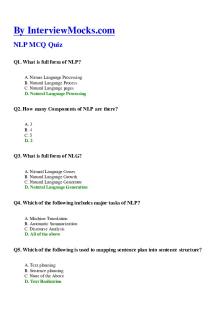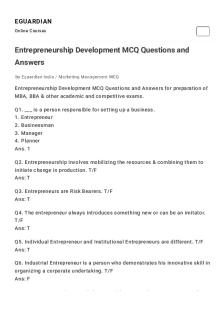Entrepreneurship Development MCQ Questions and Answers 2 PDF

| Title | Entrepreneurship Development MCQ Questions and Answers 2 |
|---|---|
| Author | raj tyagi |
| Course | Database management system |
| Institution | Swami Vivekanand University |
| Pages | 10 |
| File Size | 82.2 KB |
| File Type | |
| Total Downloads | 13 |
| Total Views | 162 |
Summary
provide mcq to give a best knowledge to give best to your exam as well as in your qhole subject grip...
Description
EGUARDIAN Online Courses
Entrepreneurship Development MCQ Questions and Answers
Entrepreneurship Development MCQ Questions and Answers for preparation of MBA, BBA & other academic and competitive exams. Q1. ___ is a person responsible for setting up a business. 1. Entrepreneur 2. Businessman 3. Manager 4. Planner Ans. 1 Q2. Entrepreneurship involves mobilizing the resources & combining them to initiate change in production. T/F Ans: T Q3. Entrepreneurs are Risk Bearers. T/F Ans: T Q4. The entrepreneur always introduces something new or can be an imitator. T/F Ans: T Q5. Individual Entrepreneur and Institutional Entrepreneurs are different. T/F Ans: T Q6. Industrial Entrepreneur is a person who demonstrates his innovative skill in organizing a corporate undertaking. T/F Ans: F fl
l b
lk
l
d
Q7. Entrepreneur of large scale business like Tata, Birla, Etc are Instigated Entrepreneur T/F Ans: F Q8. An induced Entrepreneur is one who is induced to take up an entrepreneurial activity due to policy measures of the government to start a new venture. T/F Ans: T. Q9.An Entrepreneur is different from a manager T/F Ans. T Q10.Bank Overdraft is a source of short term Finance T/F Ans T Q11. Trade Credits are a source of Long term Finance T/F Ans: F Q12. Borrowing of large money at a rate of interest fairly higher than the actual rate of return on its capital employed is a cause of overcapitalization T/F Ans: T Q13. To reduce the claims of shareholders, debentures holders & creditors is a remedial measure for over-Capitalization. T/F Ans: T Q14. IFCW stands for ___ 1. International Finance Company, Washington. 2. International Finance Corporation, Washington. 3. Intercompany Finance Corporation, Washington. 4. International Federal Corporation, Washington. Ans.2 Q15. EICI stands for___ 1. Export Inspector of Council of India 2. Export Inspection Company of India 3. Export Inspection Council of India 4. Export Investigation Council of India
Ans: 3
Q16. ECGC stands for ___ 1. Export Credit & Guarantee Company 2. Export Company & Guarantee Corporation 3. Export Credit & Guarantee Collaboration 4. Export Credit & Guarantee Corporation Ans: 4 Q17. SIDO stands for ___ 1. Small Industries Developing Organization 2. Small Industries Development Organization 3. Short Industries Development Organization 4. Small Industries Deployment Organization Ans: 2 Q18. DIC stands for ______ 1. Disassembled Industries Centers 2. District Industries Collaboration 3. District Industries Centers 4. Developing Industries Centers Ans: 3 Q19. NIESBUD stands for ___ 1. National Institution for Entrepreneurship & Small Business Development 2. National Institute for Enterprise & Small Business Development 3. National Institute for Entrepreneurship & Small Business Development 4. National Institute for Entrepreneurship & Small Businessman Development Ans: 3 Q20. XISS stands for ___ 1. Xavious Institute of Social Service 2. Xavier Institute of Social Service 3. Xavier Institute of Socializing Service 4. Xavier Institution of Social Service Ans: 2
Ans: 2
Q21. MPCO stands for ___ 1. Madhya Pradesh Company for Organization Ltd. 2. Madhya Pradesh Consultant for Organization Ltd. 3. Middle Planning Consultancy Organization Ltd. 4. Madhya Pradesh Consultancy Organization Ltd. Ans: 4 Q22. CYSEC stands for ___ 1. Calcutta ‘Yes’ Self-employment Centre. 2. Calcutta ‘Y’ Self-employment Centre. 3. Calcutta ‘Y’ Self-employment Company. 4. Calcutta ‘Y’ Service-employment Centre. Ans: 2 Q23. IDBI stands for ___ 1. Industry Development Bank of India 2. Industrial Development Bank of Investment 3. Industrial Development by Bank of India 4. Industrial Development Bank of India Ans: 4 Q25. TCO stands for ___ 1. Tata Consultancy Organization 2. Technical Company Organization 3. Technical Configured Organization 4. Technical Consultancy Organization Ans: 4 Q26. EGB stands for ___ 1. Enterprise Development Bureau 2. Entrepreneurial deli censing Bank 3. Entrepreneurial Development Bureau 4. Entrepreneur Development Bureau Ans: 3
Ans: 3
Q27. CED stands for ___ 1. Centre for Enterprise Development 2. Consultancy for entrepreneurship Development 3. Centre for entrepreneurship Deployment 4. Centre for entrepreneurship Development Ans: 4 Q28. SIET stands for ___ 1. Small Industries Extension & Training Enterprise 2. Small Industries Extension & Training Institute 3. Small Industries Extension & Training Institute 4. Small Investment Expansion & Trading Institute Ans: 2 Q29. RCF stands for ___ 1. Revising Capital foundation 2. Remedial Capital foundation 3. Risk Capital foundation 4. Risk Capital formation Ans: 3 Q30. DGTD stands for ___ 1. Directing Guidelines of Technical Development 2. Directorate General of Training & Development 3. Directorate General of Technical Development 4. Directorate Governor of Technical Development Ans: 3
Q31. IIC stands for ___ 1. Investment Institution Centre 2. Indian Investment Company 3. Indian Investment Centre 4. Indian Investment Corporation
Ans: 3
Q32. ICICI stands for ____ 1. Industrial Company & Investment Corporation of India Limited 2. Industrial Corporation & Investment Company of India Limited 3. Industrial Credit & Investment Corporation of India Limited 4. Investment Credit & Investment Corporation of India Limited Ans: 3 Q33. Who toke the lead to extend financial assistance to small-scale industries 1. SBI 2. IFCI 3. IRBI 4. None of the above Ans: 1 Q34. which act was passed by parliament on September 28,1951 1. State Funds for Corporation Act 2.State Finance Company Act 3. State Finance Corporation Act 4. Small Finance Corporation Act Ans: 3 Q35. The LIC was established under the LIC Act in 1. 1954 2. 1950 3. 1956 4. None of the above Ans: 3 Q36. ____ Capitalization signifies a situation when an enterprise possesses an excess assets in relation to its requirement. 1. Under 2. Over 3. Actual 4 proper
4. proper Ans: 2 Q37. To split up the shares of the enterprise is a remedial measure for ___ Capitalization 1. Over 2. Under 3. Actual 4. None of the above Ans: 2 Q38. TQI, SQM, TQC are various names for TQM. T/F Ans: T Q39 TQM & ISO 9000 both focus on customer satisfaction. T/F Ans: F Q40. Is Diversification a costly proposition? T/F Ans: T Q 42. “Seed Capital Scheme” has been operated by 1. SBI 2. IDBI 3. NSCI 4. None of the above Ans : 2 Q43. An ___ in a tract of land which is subdivided and developed according to a comprehensive plan for the use of a community of industrial enterprises. 1. Industrial plan 2. Industrial Estate 3. Industrial unit 4. None of the above Ans: 2 Q44. ___ signifies a situation when an enterprise process excess assets in relation to its requirement.
1. Over capitalization 2. profit 3. proper capitalization 4. Actual capitalization Ans: 1 Q45. The small sector was classified into three categories by IRP 1977 1.Cottage & household industries, Tiny Sector, small-scale industries. 2.Cottage & household industries, large, small-scale industries. 3.Cotton & household industries, Tiny Sector, small-scale industries. 4. Household industries, Tiny Sector, small-scale industries. Ans: 1 Q46. Engineering expenses related to the business & legal charges are examples of ___ 1. Preliminary Expenses 2. Functional Expenses 3. Operational expenses 4. None Ans: 1 Q47. On the basis of organization set-Up, the following are the type of Industrial estate 1. Government, Public, cooperative, Municipal Industrial estate 2. Government, Private, cooperative, Municipal Industrial estate 3. Government, Public, cooperative, Municipal Industrial estate 4. Government, Private, public, Municipal Industrial estate Ans: 2 Q48. Capital is arranged from Internal sources refers to the owner’s own money known as 1. Profit 2. Capital 3. Equity 4. None of the above Ans: 3
Q49. _____ is usually done by a financial institution which besides making an analysis of cost & benefits of a proposed project assesses the project from the various aspects of an investment proposition before extending finance. 1. Project planning 2. Project appraisal 3. Project costing 4. none of the above Ans: 2 Q50. According to Peter F. Drucker, there are three kinds of opportunities 1. Additive, Complementary, Breakthrough 2. Additive, Complementary, Supplementary 3. Additive, Complementary, Breakthrough 4. Additional, Complementary, Breakthrough Ans: 3 Q51. EDP concentrates its attention to give motivation, awareness to all citizens & create favourable & healthy environment. T/F Ans: F Q52. The manager needs to process distinct qualification and also bears all the risk involved in the enterprise. T/F Ans: F Q53. ___ is not the trait of entrepreneurs. 1.Innovation 2. Decision making 3. Skilful management 4. None of the above Q54. SIDO was established in. 1. 1995 2. 1991 3.1990 4.1978 Ans: 3
Q55. IPR 1956 re-emphasized the spirit of IPR 1980. T/F Ans. F Q56. IPR ___ initiated the modern SSI in India. 1. 1956 2. 1952 3. 1990 4.1948 Ans:1 Q57.The main objective of setting up DICs was to promote under a single roof all the services & support required by small & village entrepreneurs. This scheme was introduced in May ___ 1. 1970 2. 1975 3. 1978 4. None of the above Ans: 3 Q58. MODVAT is to shift the burden of excise taxation away from inputs on to their final products. T/F Ans. T Q59. Diversification is an example of Internal growth strategy & Merger is an example of an External growth strategy. T/F Ans: T Q60. Which is not the content of the Project Report? 1. Transport 2. Products 3. Communication 4. All the above MCQ Questions for Entrepreneurship Development: Set-1...
Similar Free PDFs

Nlp questions and answers mcq
- 6 Pages

Entrepreneurship-Development
- 15 Pages

ENTREPRENEURSHIP DEVELOPMENT
- 71 Pages

Entrepreneurship mcq 1
- 13 Pages

2, questions and answers
- 34 Pages

Mcq-on-training-and-development
- 3 Pages
Popular Institutions
- Tinajero National High School - Annex
- Politeknik Caltex Riau
- Yokohama City University
- SGT University
- University of Al-Qadisiyah
- Divine Word College of Vigan
- Techniek College Rotterdam
- Universidade de Santiago
- Universiti Teknologi MARA Cawangan Johor Kampus Pasir Gudang
- Poltekkes Kemenkes Yogyakarta
- Baguio City National High School
- Colegio san marcos
- preparatoria uno
- Centro de Bachillerato Tecnológico Industrial y de Servicios No. 107
- Dalian Maritime University
- Quang Trung Secondary School
- Colegio Tecnológico en Informática
- Corporación Regional de Educación Superior
- Grupo CEDVA
- Dar Al Uloom University
- Centro de Estudios Preuniversitarios de la Universidad Nacional de Ingeniería
- 上智大学
- Aakash International School, Nuna Majara
- San Felipe Neri Catholic School
- Kang Chiao International School - New Taipei City
- Misamis Occidental National High School
- Institución Educativa Escuela Normal Juan Ladrilleros
- Kolehiyo ng Pantukan
- Batanes State College
- Instituto Continental
- Sekolah Menengah Kejuruan Kesehatan Kaltara (Tarakan)
- Colegio de La Inmaculada Concepcion - Cebu









